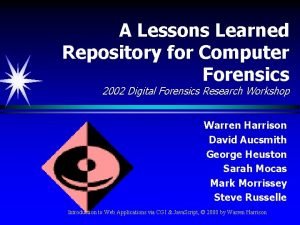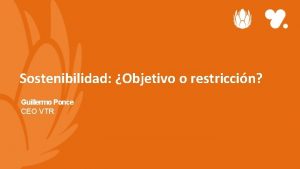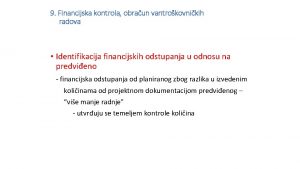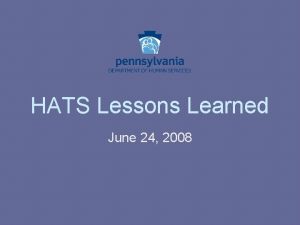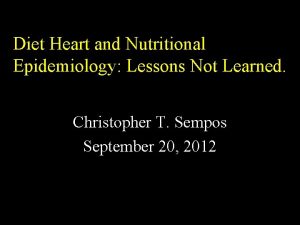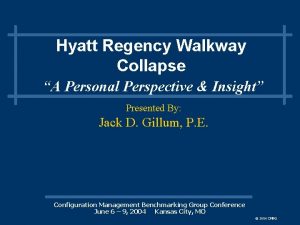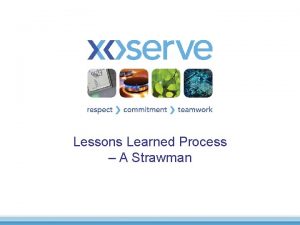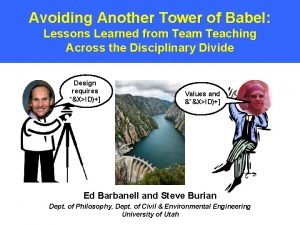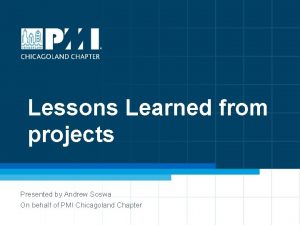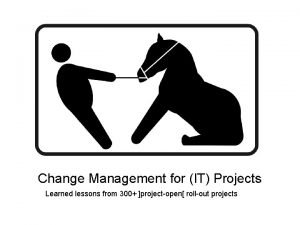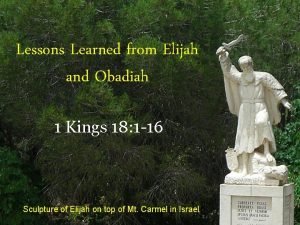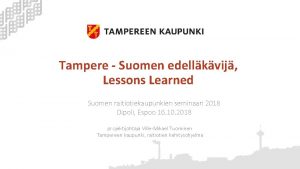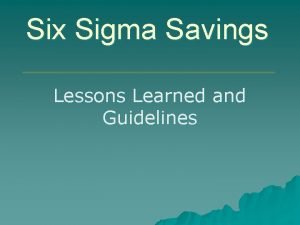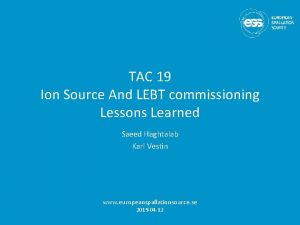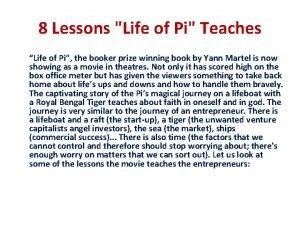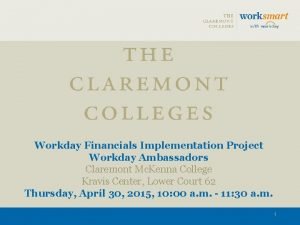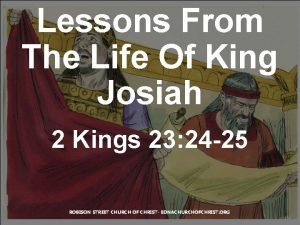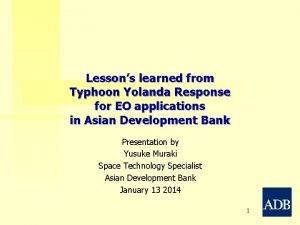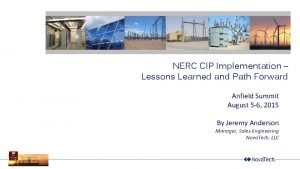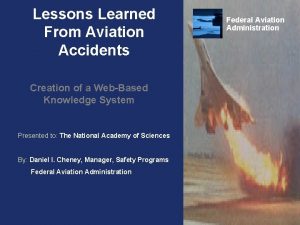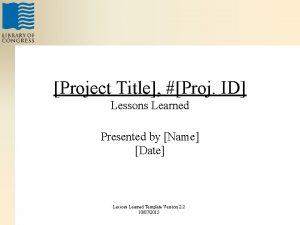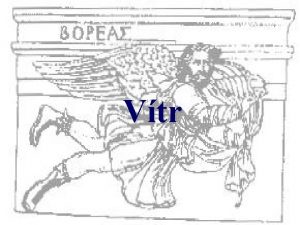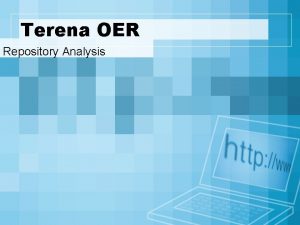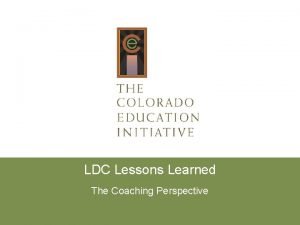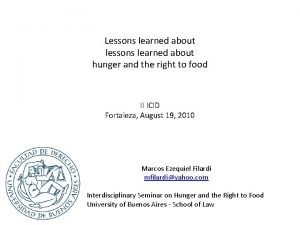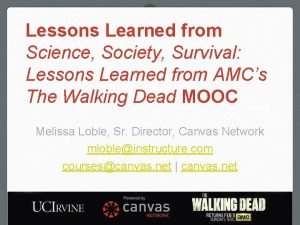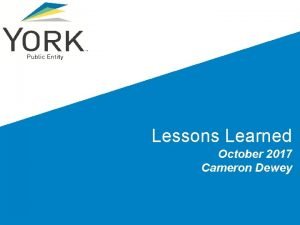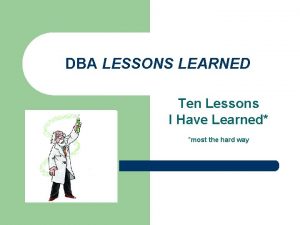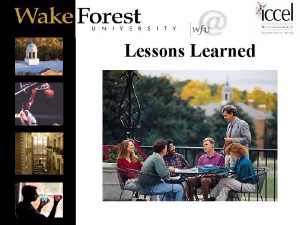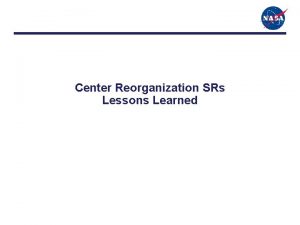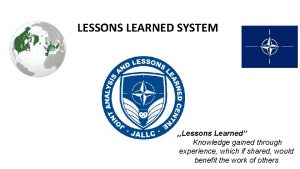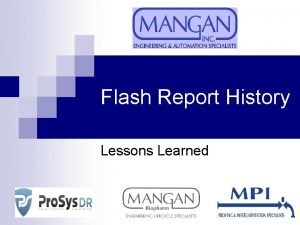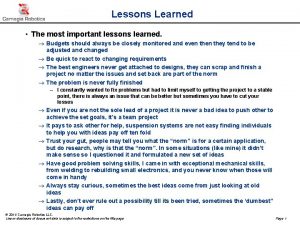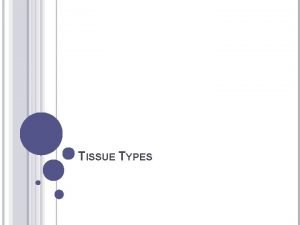SEERLinked Virtual Tissue Repository VTR Lessons Learned for






















- Slides: 22

SEER-Linked Virtual Tissue Repository (VTR): Lessons Learned for Scaling Alison L. Van Dyke, MD, Ph. D June 11, 2019

Outline § Unmet Need & VTR Goal § VTR Concept & Pilot Program § Pancreatic Cancer Technical Pilot • Findings & Lessons Learned § Scale Up Planning § Summary 2

Unmet Need & VTR Goal §Problem: • Current tissue-based research often performed on limited population enrolled in clinical trials • Community-based specimens that reflect larger cancer population are often not used in research §Objectives: • Provide infrastructure for tissue & data collection on a population level • Enable use of community-based tissue specimens for biomedical research 3

Rationale for SEER-Linked VTR • Population-based • Research on rare cancers/subtypes & rare outcomes • Renewable resource >500, 000 cases/year • Cancer registries are uniquely positioned o. Collect & maintain identifiers for active longitudinal follow-up o. Established relationships w/ local hospitals & pathology labs o. Extensive experience in data collection o. Maintain clinical annotation §Several SEER registries support biospecimen-based research through Residual Tissue Repositories (RTR) 4

2 4 1 3 5

VTR Pilot Projects & Objectives §To establish best practices & feasibility of VTR §Pathology laboratory inventory §Whole slide imaging project §Two use-case projects of unusual outcomes • Pancreatic ductal adenocarcinoma (PDAC) • Breast cancer • Molecular studies on DNA & RNA from archival FFPE o. Use of FFPE tissue for molecular studies controversial 6

SEER Sites Participating in Pilot Greater California Connecticut Hawaii Iowa Kentucky Louisiana Utah 7

Objectives of Molecular Studies §Feasibility & best practices for obtaining FFPE tissue for molecular studies via SEER program §Feasibility of molecular studies & quality of molecular data obtained using DNA/RNA from diagnostic, archival FFPE §Identification of factors associated w/ survival • Genomic & transcriptomic signatures • Clinical & treatment characteristics §Associations b/w molecular & clinical characteristics 8

VTR PDAC Pilot §Comparing 100 PDAC pairs • Unusual survival (5 years) • Usual survival (≤ 2 years) §VTR Technical Pilot • Subset of 24 pairs • Determination of tests for study on rest of pairs §Molecular Studies • Tumor & Normal: WGS & WES • Tumor: methylation studies & RNASeq 9

Tissue Age & DNA Quality P <0. 001 10

Sequencing Quality Summary §DNA & Whole Genome Sequencing • Good quality achieved with DNA from archival tumor & normal/nontumor FFPE tissue • Small decrease in WGS quality in specimens >10 yrs §RNA & RNA Sequencing • High quantity & poor quality of tumor RNA obtained 11

VTR Pilot: Challenges Faced §Variability in laboratory policies for sharing tissue §Obtaining Tissue • For cancer subjects pair-matched across registries • Destroyed when CAP retention requirements met (after 10 yrs) • Variability in registry’s relationships w/ labs • Destruction by natural disaster (e. g. , hurricane prone regions) • Competing demands for tissue • Laboratory fees for determining tissue availability 12

VTR PDAC Pilot: Challenges Faced § Tissue-based sources of subject failure • Tissue not available • Tissue depleted for other purposes • Tumor determined to not be PDAC by expert pathologist • Too much necrosis • Insufficient tumor cellularity 13

VTR Pilot: Lessons Learned §VTR Pilot essential for: • Understanding best practices, barriers, & limitations • Estimating realistic time frames • Assessing cost to registries, pathology laboratories & investigators • Evaluate usability of archival FFPE tissue blocks for molecular studies • Understanding need to oversample §Concurrent expansion of RTRs needed 14

Planning for Scaling the VTR §Project proposal review, approval, & tracking • Proposal submission & review system • Review board to include registries, NCI, scientists, & patient advocates/patients §Funding Mechanisms • Partial support for VTR personnel at each registry • Investigator support through grants §Investigator search, sample selection, & specimen requests 15

16

17

Summary §SEER well-suited for development of VTR §SEER-Linked VTR infrastructure is feasible §Archival, diagnostic FFPE tissue is obtainable & suitable for some molecular studies §Concurrent expansion of RTRs is critical to success of future VTR to capture discarded specimens 18

Current VTR Team Lynne Penberthy Valentina Petkov Alison Van Dyke Serban Negoita Sarah Hussey Connor Valenzuela Yao Yuan Mandi Yu Steve Friedman Rose Mills 19

SRP Lynne Penberthy Matrisian Valentina Petkov Sarah Hussey Yao Yuan Connor Valenzuela Steve Friedman Rose Mills Mandi Yu Serban Negoita SRP Formerly Involved Sean Altekruse Jessica Boten Alyssa Wang Radim Moravec Marina Matatova Acknowledgements SEER Registry PIs Rosemary Cress Pan. CAN Lynn Brenda Hernandez Charles Lynch Lloyd Mueller Carol Sweeney Tom Tucker Xiao-Cheng Wu Lola Rahib William Hoos SEER Registry Staff Other NCI Elizabeth Gillanders Danielle Carrick Ed Helton Ulrike Wagner Emory Univ. Ashish Sharma Stony Brook Joel Saltz Rajarsa Gupta Tahsin Kurc UPMC Aatur Singhi MD Anderson 20

Contact: Alison Van Dyke, MD, Ph. D alison. vandyke@nih. gov 21

Tissue Age & RNA Quality P <0. 05 22
 Lessons learned repository
Lessons learned repository Ceo vtr
Ceo vtr Terminal locked vtr
Terminal locked vtr Vtr radovi
Vtr radovi Lessons learned ground rules
Lessons learned ground rules Lessons not learned in blood
Lessons not learned in blood Hyatt regency walkway collapse lessons learned
Hyatt regency walkway collapse lessons learned Strawman report
Strawman report Lessons learned from the tower of babel
Lessons learned from the tower of babel Lesson learned register
Lesson learned register Lesson from the ants
Lesson from the ants Change management lessons learned
Change management lessons learned Lessons from elijah
Lessons from elijah Lessons learned suomeksi
Lessons learned suomeksi Six sigma lessons learned
Six sigma lessons learned Tac lessons learned
Tac lessons learned Life of pi lessons
Life of pi lessons Workday claremont colleges
Workday claremont colleges Is josiah luke a dwarf
Is josiah luke a dwarf Lesson learned in typhoon yolanda
Lesson learned in typhoon yolanda Nerc lessons learned
Nerc lessons learned Lessons learned faa
Lessons learned faa Dps project title
Dps project title
